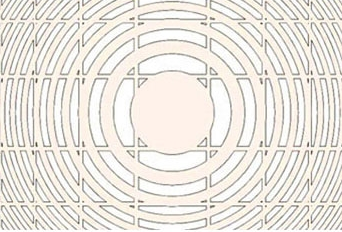
Science and technology.
科技。
The search for alien life
寻找外星生物
Twinkle, twinkle, little planet
闪烁吧,小行星
An undervalued optical trick may help to find life in other solar systems
一个不被人重视的光学方法可能能帮助寻找其他太阳系的生命
MOST astronomical telescopes employ reflection to focus starlight. A concave mirror creates an image from this light using a design pioneered in the 17th century, by Sir Isaac Newton. Those telescopes that do not employ reflection use refraction. They have a system of lenses, an idea first used to look at the stars by Galileo.
大部分天文望远镜都是运用的焦点星光的反射原理。早在17世纪,艾萨克.牛顿就开创性的利用这个光,让凹透镜产生了一个图像。那些不利用反射的望远镜利用的是折射。他们有透镜系统。利用透镜系统的想法最早是伽利略用来观测星星的。
But there is a third way to focus light. A century and a half after Newton, and more than two after Galileo, a Frenchman called Augustin-Jean Fresnel worked out that you can do it using diffraction. A set of concentric rings, alternately transparent and opaque, will scatter and spread light waves in a manner that causes them to reinforce each other some distance away, and thus form an image. The rings are known as a zone plate. And Fresnel's countryman, Laurent Koechlin, of the Midi-Pyrenees observatory, thinks zone plates are the way to find out if there is life on other planets.
但还存在第三种聚焦光源的方法。在牛顿利用星光的150年后,伽利略的透镜系统的两百多年后,一个名叫奥古斯丁.让.菲涅尔的法国人想到也可以利用衍射来达到目的。一组兼有透明和不透明的同轴环可以分散和传播光波,并且在稍远的地方可以再使他们重新聚焦,由此形成一个图像。这些环被称作波带片。法国南比利牛斯天文台劳伦.凯什兰认为波带片可以用来寻找其他星球上是否存在生命。
Seeing oxygen in another planet's atmosphere would be a giveaway of biological activity because the gas is so reactive that it needs to be continuously renewed. That would almost certainly mean something akin to photosynthesis was going on, for no known non-biological process can produce oxygen from common materials in sufficient quantity. Looking at such an atmosphere, though, is tricky. Stars are so much brighter than the planets which orbit them that their light overwhelms the small amount reflected from a planet's surface. And this is where Fresnel comes in.
在其他星球的大气层发现氧气则表明这个星球上有生物活动,因为氧气是一种非常活跃的气体,所以他需要不停的更新。而这也就基本上意味着星球上进行着某些类似于光合作用的活动,因为在我们已知的非生物学过程中,没有一种过程可以在普通材料供应充足的情况下产生氧气。然而,观测到这样的大气层也是非常难的。恒星比以他们为轨道运行的行星亮得多。他们的光盖过了从行星表面上反射过来的少量光。而这也就是菲涅尔的突破口。
Fresnel telescopes have not been developed in the past because the image formed by one that was large enough to rival a useful-sized reflecting telescope would be several kilometres from the zone plate. But Dr Koechlin does not worry about that, because his Fresnel telescope will be in space. Free of the confounding effects of the Earth's own atmosphere, it will be able to isolate images of alien planets, make spectra of the light from their air, and examine those spectra for the characteristic dark lines that are caused by part of the light being absorbed by particular gases-oxygen among them.
过去,菲涅尔设计的望远镜还制造不出来,因为要想使衍射望远镜的大小和正常使用的反射望远镜大小相同,它所产生的图像就会距离波带片数千米远。然而,凯什兰博士并不为此担心,因为他的菲涅尔望远镜将会在太空中。脱离了地球大气层的混淆效应,望远镜将能够分离外星生物的图像,在他们的大气中制作出来光谱,并且为这些有特点的暗线检查光谱。这些暗线部分是由特殊气体——大气中的氧气——所吸收的光产生的。
Plate tectonics
行星构造地质学
Space telescopes are nothing new, of course, and several more are in the works (see article). But existing plans to photograph extrasolar planets in this way involve orbiting arrays of reflecting telescopes all pointing in exactly the same direction. An array is needed because a single mirror big enough to do the job of separating star from planet would be too large to launch. The problem is the word "exactly". It means just that. The formation would have to fly with a precision of a few billionths of a metre.
当然,太空望远镜并不是什么新事物,并且已经有几个已经在使用中了(见文章)。但是在现在的计划中,利用这种方法给太阳系以外的行星拍照就需要让多组的反射望远镜在轨道运行的时候全部精准的朝向同一个方向。由于一个体积足够大到能够将恒星与行星分开的单一镜面将会由于体积太庞大而无法发射,因此一组反射望远镜就是必须的。而问题就出在"精准"上。它就如字面意思一样,要精准到十亿分之一米。
Using a zone plate instead of a mirror gets around this. Because the plate is flat, it can be made of plastic and folded up for launch. Size thus ceases to be an issue. And although a second satellite containing the "eyepiece" (a special lens that also uses Fresnel optics, and a camera to record the image) must fly at the focus, the accuracy required is only hundredths of a metre, not billionths. That, Dr Koechlin reckons, gives Fresnel optics a big advantage over Newtonian ones.
用波带片代替镜面在轨道运行。因为波带片表面是平的,他可以用塑料制作而成,然后折叠起来发射。而尺寸大小就不再是问题。并且,尽管还必须有一个含有"目镜"(也是一种运用菲涅尔视觉的特殊透镜,也是一种记录图像的相机)的卫星在焦点上运行,所需要的精准度也只是百分之一米。凯什兰博士认为,这将是菲涅尔视觉超越牛顿的设计的一大优点。
To test the idea, he and an international consortium of his colleagues have built a ground-based prototype. This is a piece of copper foil 20cm square that has 696 rings, a portion of which is reproduced above. Because it is this small, its focal length is only 18 metres. In order that the foil does not fall apart, each transparent ring is actually a series of curved slots in the copper rather than a continuous gap. This, though, does not affect the system's optical properties and it can, indeed, see small, faint objects that are near large, bright ones.
为了检测这一想法,他和他各国的同事建立了一个陆基的雏形。这是一片20平方厘米的铜箔,它有696个环。铜箔的一部分是再生的。因为它体积偏小,所以它的聚焦只有18米。为了不让铜箔散开,每一个透明的环实际上都是铜箔里的一系列的曲线轮槽,而不是连续的空隙。尽管如此,这并不影响整个系统的视觉特性,并且,它也确实能够看见巨大且明亮的恒星旁边那些小型且微弱的物体。
When Dr Koechlin and his team pointed it at Mars they could distinguish that planet's two tiny moons-a task which would require a Newtonian telescope with a mirror at least 30cm across. And when they aimed at Sirius they could see the dim white-dwarf which orbits what is the brightest star in the night sky. Extrapolating from these results, they think that an orbiting zone plate measuring somewhere between 15 metres and 40 metres across will be enough to distinguish the spectrum of an Earthlike planet at a distance of 30 light-years. With that, they should be able to find out if mankind really does have any next-door neighbours, and Fresnel will have come into his own at last.
当凯什兰博士和他的团队观测火星时,他们可以分辨火星的两个微小卫星——这样的任务如果是利用牛顿的望远镜则需要一个直径最少长达30厘米的镜面。并且,当他们观测天王星时,他们能够看见暗淡的白矮星。它围绕着夜空中最亮的那颗星运行。从这些结果推测,他们认为,一个直径在15到40米、并且在轨道上运行的波带片足够在30光年以外的距离分辨一个与地球相似的行星的光谱。如此一来,他们就应该能够找到人类是否还有其他邻居,而菲涅尔也最终能实现自己的想法。












